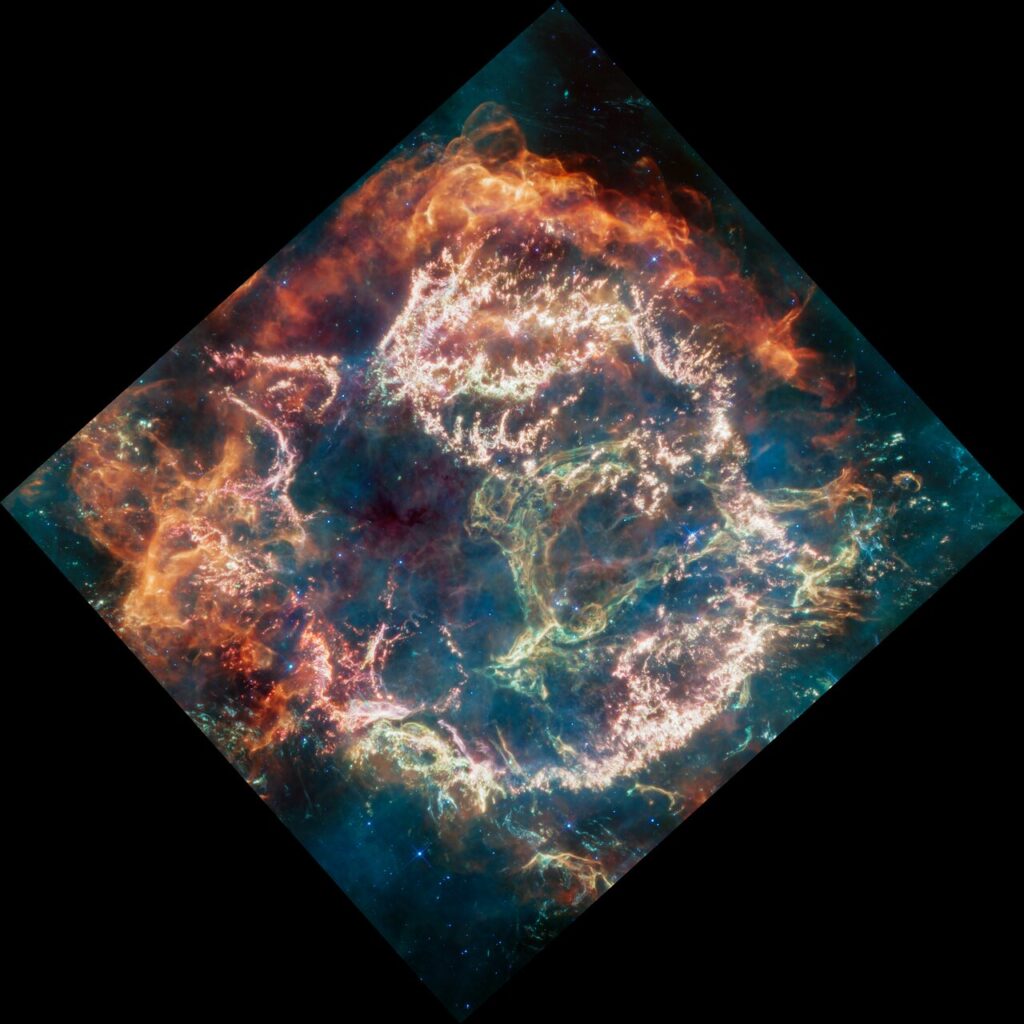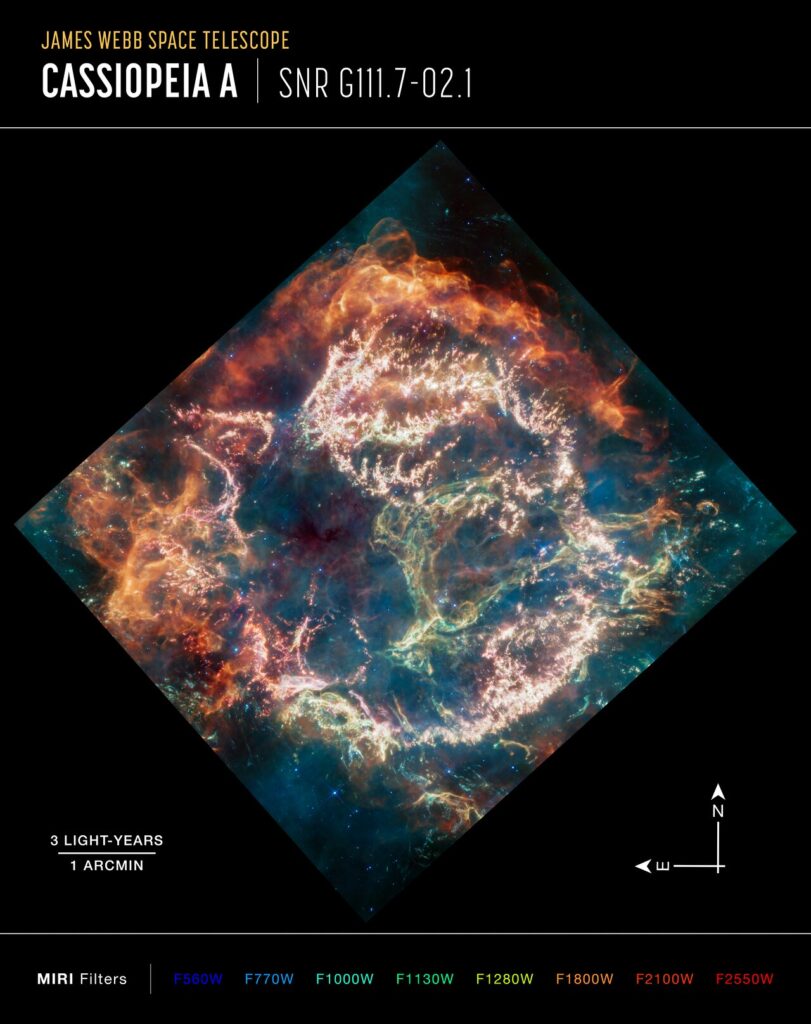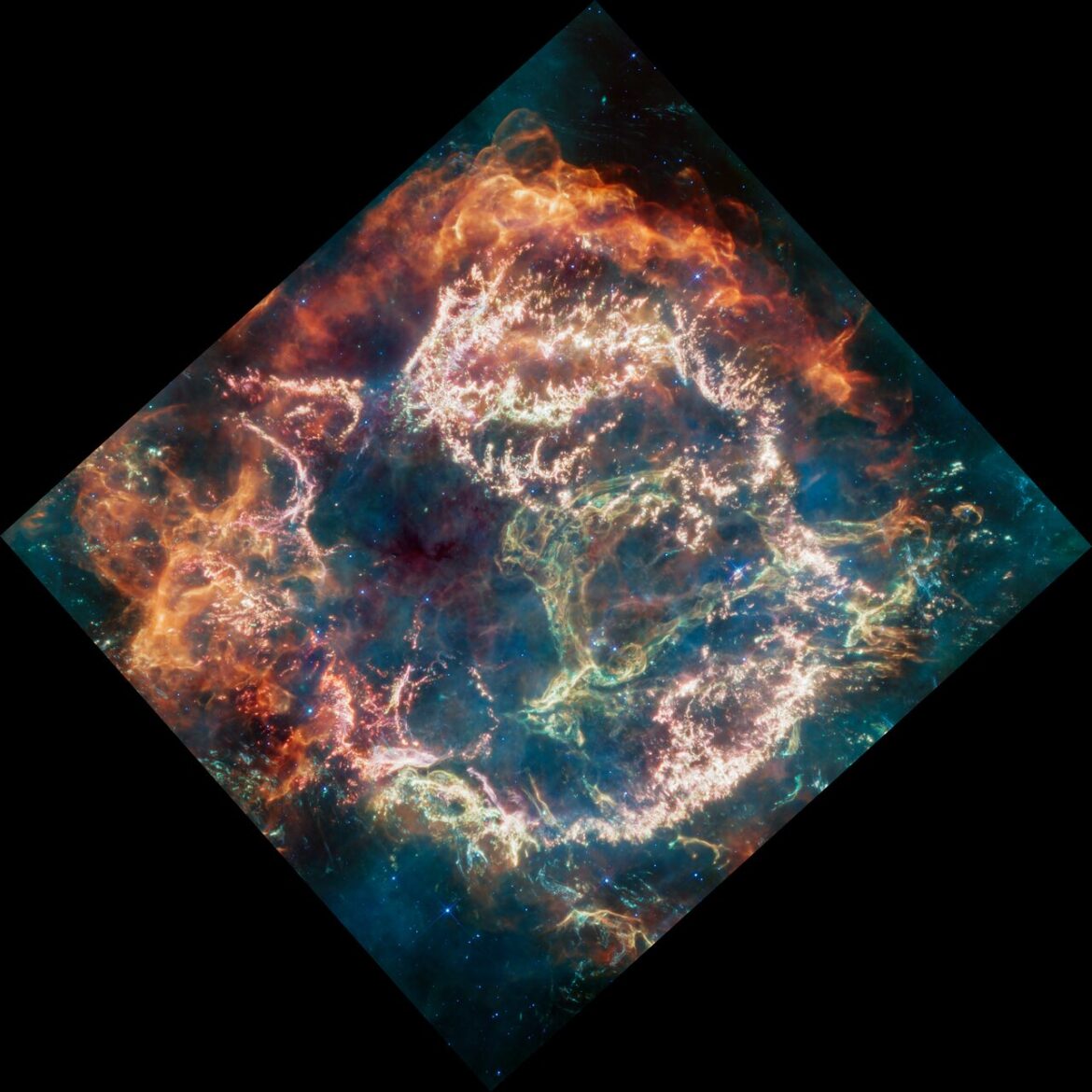The James Webb Space Telescope reveals new details in supernova remnant Cassiopeia A (Cas A)
The explosion of a star is a dramatic event, but the remains that the star leaves behind can be even more dramatic. A new mid-infrared image from NASA/ESA/CSA James Webb Space Telescope provides one stunning example. It shows the supernova remnant Cassiopeia A (Cas A), created by a stellar explosion 340 years ago. The image displays vivid colours and intricate structures begging to be examined more closely. Cas A is the youngest known remnant of an exploding, massive star in our galaxy, offering astronomers an opportunity to perform stellar forensics to understand the star’s death.
Cassiopeia A is a prototypical supernova remnant that has been widely studied by a number of ground-based and space-based observatories. The multi-wavelength observations can be combined to provide scientists with a more comprehensive understanding of the remnant.
The striking colours of the new Cas A image, in which infrared light is translated into visible-light wavelengths, hold a wealth of scientific information that researchers are just beginning to tease out. On the bubble’s exterior, particularly at the top and left, lie curtains of material appearing orange and red that are due to emission from warm dust. This marks where ejected material from the exploded star is ramming into surrounding circumstellar gas and dust.

On the remnant’s exterior, particularly at the top and left, lie curtains of material appearing orange and red that are due to emission from warm dust. This marks where ejected material from the exploded star is ramming into surrounding circumstellar material.
Interior to this outer shell lie mottled filaments of bright pink studded with clumps and knots. This represents material from the star itself, and likely shines by the light produced by a mix of heavy elements and dust emission. The stellar material can also be seen as fainter wisps near the cavity’s interior.
A loop represented in green extends across the right side of the central cavity. Its shape and complexity are unexpected and challenging for scientists to understand.
This image combines data from various filters, with the colour red assigned to 25.5 microns (F2550W), orange-red to 21 microns (F2100W), orange to 18 microns (F1800W), yellow to 12.8 microns (F1280W), green to 11.3 microns (F1130W), cyan to 10 microns (F1000W), light blue to 7.7 microns (F770W), and blue to 5.6 microns (F560W). The data come from the general observer program 1947.
Credit:
NASA, ESA, CSA, D. Milisavljevic (Purdue University), T. Temim (Princeton University), I. De Looze (UGent), J. DePasquale (STScI)
Interior to this outer shell lie mottled filaments of bright pink studded with clumps and knots. This represents material from the star itself, which is shining by the light produced by a mix of heavy elements, such as oxygen, argon, and neon, as well as dust emission. The stellar material can also be seen as fainter wisps near the cavity’s interior.
Among the science questions that Cas A may help answer is: where does cosmic dust come from? Observations have found that even very young galaxies in the early Universe are suffused with massive quantities of dust. It’s difficult to explain the origins of this dust without invoking supernovae, which spew large quantities of heavy elements (the building blocks of dust) across space.
However, existing observations of supernovae have been unable to conclusively explain the amount of dust we see in those early galaxies. By studying Cas A with Webb, astronomers hope to gain a better understanding of its dust content, which can help inform our understanding of where the building blocks of planets — and ourselves — are created.
Supernovae like the one that formed Cas A are crucial for life as we know it. They spread elements like the calcium we find in our bones and the iron in our blood across interstellar space, seeding new generations of stars and planets.
The Cas A remnant spans about 10 light-years and is located 11 000 light-years away in the constellation Cassiopeia.

On the remnant’s exterior, particularly at the top and left, lie curtains of material appearing orange and red due to emission from warm dust. This marks where ejected material from the exploded star is ramming into surrounding circumstellar material.
Interior to this outer shell lie mottled filaments of bright pink studded with clumps and knots. This represents material from the star itself, and likely shines due to a mix of various heavy elements and dust emission. The stellar material can also be seen as fainter wisps near the cavity’s interior.
A loop represented in green extends across the right side of the central cavity. Its shape and complexity are unexpected and challenging for scientists to understand.
This image combines various filters with the colour red assigned to 25.5 microns (F2550W), orange-red to 21 microns (F2100W), orange to 18 microns (F1800W), yellow to 12.8 microns (F1280W), green to 11.3 microns (F1130W), cyan to 10 microns (F1000W), light blue to 7.7 microns (F770W), and blue to 5.6 microns (F560W). The data comes from the general observer program 1947.
[Image description: A roughly square image is rotated clockwise about 45 degrees. Within the image is a circular-shaped nebula with complex structure. On the circle’s exterior lie curtains of material glowing orange. Interior to this outer shell lies a ring of mottled filaments of bright pink studded with clumps and knots. At center right, a greenish loop extends from the right side of the ring into the central cavity. Translucent wisps of blue, green, and red appear throughout the image.]
Credit:
NASA, ESA, CSA, D. Milisavljevic (Purdue University), T. Temim (Princeton University), I. De Looze (UGent), J. DePasquale (STScI)




